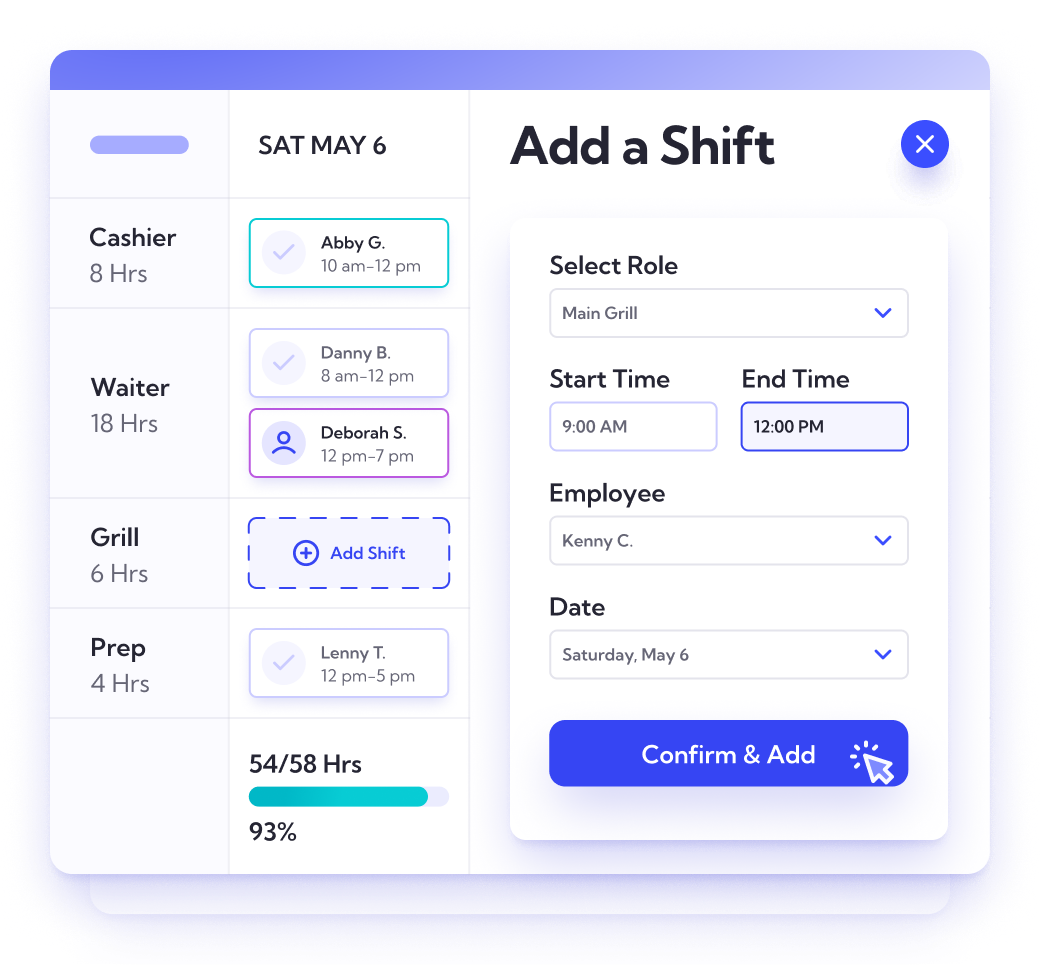Anyone who has worked in the service industry knows how hectic and exhausting it can be. Peak hours are hectic, shifts can be long, people often work double shifts, and it’s labor-intensive work. That’s why many states have laws around how long people can work without a break, and sometimes requiring restaurants to provide time for a meal.
Making sure your employees are refreshed and focused is important, and there are few things worse for a restaurant’s reputation than being known for breaking restaurant labor laws. With that in mind, it’s a good idea to make sure you’re familiar with your state’s break and mealtime laws so you can stay in compliance and keep your workers happy.
Let’s take a comprehensive look at restaurant break and meal laws, some of the more unique approaches some states take, what constitutes a break, and what happens when restaurants break the rules.
Understanding Restaurant Break Laws
There are very few if any laws that apply specifically to restaurants. Often they’re lumped in with all labor, or service and retail industries.
The definition of a break varies from state to state, but the general idea is that it’s a break in a shift when an employee is not required to work or perform any duties pertaining to work. These breaks can be either paid or unpaid depending on the law, the duration of the break, or individual business policies. They still require the regular rate of pay and cannot be below the state minimum wage.
Tipped employees are often under the same rules as regular hourly employees.
Breaks are great for workers as they provide them with a moment during a work period to relax and recharge in the middle of a hectic shift.
This can be of benefit to employers as well since it helps avoid burnout and the mistakes that come with it. It is a smart practice to look ahead at demand forecasts so that you can schedule breaks when there won’t be as much need for all-hands to be on the clock and not on break.
Types of Breaks and Requirements
There are two major types of breaks in the restaurant industry, meal breaks and rest breaks. Break time often varies between the two but not always. Extremely short breaks are sometimes not counted. Things like time off or sick leave don’t factor in either. Still, rest break requirements tend to be split into these two types. Let’s take a look at both.
Meal Breaks

When working extended shifts, especially those that occur during traditional meal periods, it can be tough without time to stop and have a meal. That’s why meal break laws are some of the most common break laws in the country.
These breaks typically last anywhere from ten minutes to an hour. They can be either a paid or unpaid meal break, but most cases will pay anything under 30 minutes while requiring employees to clock out for anything longer.
Often, these laws will only go into effect after a certain consecutive number of hours during the workday have been worked. Lunch breaks are generally the most common.
Rest Breaks
Rest breaks are the most common, but also the most varied. These are simply breaks where an employee stops working for a bit and is on their “own time” without having to worry about work responsibilities.
They are similar to meal breaks in that they usually require a certain number of consecutive hours or work time before they go into effect, they can be paid or unpaid, the duration of the rest period matters, and the rules vary from state to state. Most places won’t recognize a one-minute rest break, but once a break hits five minutes it is often noted.
Federal vs. State Laws on Meal and Breaks
The FLSA does not require restaurants to offer meals or breaks to workers.
That being said, if a restaurant offers breaks, the U.S. Department of Labor has some state rules for rests and and meals in place. Breaks of less than 30 minutes must be compensated as normal work, whereas compensation is not required for anything 30 minutes or longer.
Employers must clarify up front how long an employee’s break period is in order to avoid confusion. These rules apply if the workplace is in a state that does not have their own laws regarding breaks.
Laws vary from state to state. We won’t go into every single state, that can be found here. There are some interesting distinctions we’d like to call out.
For example, states like Alaska, Florida, Iowa, and others have rules requiring minors to receive breaks after working five consecutive hours, but those rules aren’t in place for adults.
The Fair Labor Standards Act and protections for child labor play roles as well. There may be other non-exempt employees, rules that impact overtime pay, and even healthcare concerns.
States with no rules at all include:
- Arizona
- Arkansas
- Georgia
- Idaho
- Kansas
- Mississippi
- Missouri
- Montana
- New Mexico
- South Carolina
- South Dakota
- Texas
- Wyoming
These states default to the aforementioned federal law.
Some states have particularly unique rules that employers will want to watch out for.
For example, North Dakota requires a 30-minute meal break for employees working five or more hours, but it’s only in effect if there are at least two employees on duty.
In New York, the break laws stipulate that employees working six or more consecutive hours and whose shift spans the noon-day period must receive a 30-minute meal break. Additionally, employees whose shifts start before 11 AM and extend past 7 PM are entitled to an extra 20-minute break between 5 PM and 7 PM. Furthermore, if an employee's shift begins between 1 PM and 6 AM and lasts for six or more consecutive hours, they are entitled to a 45-minute meal break.
Pennsylvania, Colorado, Delaware, New Jersey, and Washington all have fairly unique rules regarding breaks that restaurant managers will want to read through. In Washington State, workers must receive a paid 10-minute rest break for every 4 hours worked, and a 30-minute meal break on shifts longer than 5 hours, with the meal break starting between the second and fifth hour of the shift.
In California, labor laws mandate specific breaks to ensure workers have time to rest and eat during their shifts. Most employees must receive a 30-minute unpaid meal break if they work more than five hours in a day. If an employee works more than 12 hours in a day, they are entitled to an additional 30-minute unpaid meal break. Additionally, workers are granted a paid 10-minute rest period for every four hours worked. These regulations help maintain employee health and productivity by providing necessary downtime during work hours.
Vermont has a fairly vague rule, stating that you must provide employees with a reasonable opportunity to have a meal or take a restroom break, and these breaks must be paid if they take less than 20 minutes.
Many states that have similar laws differ in smaller details.
For example, Maryland and Kentucky both have break laws, but in Maryland, employees get fifteen-minute breaks when they work four to six-hour shifts, and Kentucky provides ten-minute breaks every four hours of work. There are plenty of similar discrepancies, so it’s a good practice to familiarize yourself with your local laws. Some states have different rules for workers earning minimum wage or close to it.
Implementing Compliant Break Schedules
It’s smart practice for restaurant managers to consider meal and rest breaks while building work schedules. If you know your workers will be taking a break, whether it is required by law or simply a company policy, the timing during a shift is important. This is where restaurant forecasting becomes important.
Get your forecast for the workweek and look at the hourly forecast and do your best to avoid scheduling breaks during peak hours or around shift changes when you might be short-staffed.
It’s alright to move a worker’s break as long as you provide plenty of notice and you remain compliant with the law.
Lineup.ai’s auto-scheduling feature uses AI-driven forecasts and is a great way to stay in compliance while avoiding inopportune breaks during peak hours.

Common Violations and Consequences
It might not seem like a big deal in the moment, but asking a worker to forgo their break can be extremely costly. For example, in 2022 a Portland, Oregon-based hospital group was fined over $100 million for multiple violations involving breaking mealtime rules for workers. While this example is on the extreme end of the spectrum, it illustrates the severity of failing to comply.
There are different penalties for breaking meal and break laws in different states, but regardless of the severity you don’t want to earn a reputation as a business that doesn’t comply with these laws. Your local service industry is a small world. Workers talk to each other. If you break these rules often, you will eventually have difficulty hiring staff and your turnover will increase. It can even get back to your customers, costing you business.
Conclusion
As is the case with any labor laws, meal and break laws exist for very important reasons and should be adhered to at all costs. These laws help employees stay happy, healthy, and engaged, and they can be costly for restaurants to break. Fortunately, there are plenty of tools at your disposal to stay in compliance and avoid service issues while scheduling breaks for workers. Whether you’re a restaurant owner, manager, or worker, it’s smart to stay informed and seek legal advice or contact OSHA when necessary.
Frequently Asked Qestions
Are breaks required by law in the US?
In the United States, there are no federal laws that mandate breaks for employees in the private sector, except for nursing mothers who are entitled to reasonable break times to express breast milk for one year after the child's birth. However, state laws vary, with some states requiring meal and rest breaks depending on the length of the work shift. For example, some states require a 30-minute meal break if an employee works more than five hours. Short breaks of around 10-20 minutes are also mandated in a few states for every 4 hours of work. It's important to check specific state regulations for exact requirements as they differ widely across the country.
How many breaks do you get in an 8 hour shift in the US?
In the U.S., the number of breaks during an 8-hour shift depends on state law, as there is no federal mandate for breaks.
Typically, states that require breaks offer one 30-minute meal break and two 10-minute rest breaks for an 8-hour shift. However, many states do not have specific break requirements, leaving it to employer discretion. Always check local laws for accurate information.
Do fast food workers get breaks?
Most fast food employers provide break periods for employees, though the requirements vary from state to state. The Fair Labor Standards Act (FLSA) does not define any requirements for meals or other extended break periods, which are considered separate from rest periods of 5-20 minutes.
Important Notice: The information in this article is not legal advice nor does it guarantee legal accuracy. It is up to you to consider whether the information is appropriate to your needs. Legal and other matters referred to in this article are of a general nature only and are based on Lineup.ai's interpretation of laws existing at the time the article was written. This article should not be relied on in place of professional legal advice. Lineup.ai is not responsible for the content of any site owned by a third party that may be linked to this article, and no warranty is made by us concerning the suitability, accuracy, or timeliness of the content of any site that may be linked to this article. Lineup.ai disclaims all liability (except for any liability which by law cannot be excluded) for any error, inaccuracy, or omission from the information contained in this article and any loss or damage suffered by any person directly or indirectly through relying on this information.
Further read:
